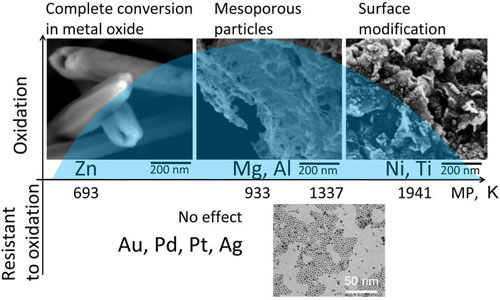| Mar 03, 2011 |
Highly precise nanostructuring using ultrasound: new procedure to produce porous metals
|
|
(Nanowerk News) They are corrosion resistant, mechanically strong and withstand exceedingly high temperatures. With such characteristics, porous metals are generating a growing interest in numerous innovative fields of technology. They are characterised by nanostructured surfaces with pores measuring only a few nanometres in diameter. An international research team including Dr Daria Andreeva of Bayreuth University (department of Physical Chemistry II) has successfully developed a heavy-duty and cost-efficient ultrasound procedure for the design and production of such metallic structures.
|
|
In this process, metals are treated in an aqueous solution in such a way that cavities of a few nanometres evolve, in precisely defined gaps. For these tailor-made structures, there is already a broad spectrum of innovative applications, including air cleaning, energy storage or medical technology. Particularly promising is the use of porous metals in nanocomposites. These are a new class of composite materials, in which a very fine matrix structure is filled with particles ranging in size up to 20 nanometres.
|
 |
| Schematic presentation of effects of acoustic cavitation on modification of metal particles. Metals with a low melting point (MP) as zinc (Zn) are completely oxidized; metals with a high melting point like nickel (Ni) and titanium (Ti) exhibit surface modification under sonication. Aluminium (Al) and magnesium (Mg) form mesoporous structures. Noble metals are resistant to ultrasound irradiation due to their stability against oxidation. The melting points of the metals are specified in degrees Kelvin (K). (Images: Dr Daria Andreeva, Department of Physical Chemistry II)
|
|
The new technique utilises a process of bubble formation, which is termed cavitation in physics (derived from lat. "cavus" = "hollow"). In seafaring, this process is feared due to the great damage it can cause to ship propellers and turbines. For at very high rotation speeds, steam bubbles form under water. After a short period under extremely high pressure the bubbles collapse inwardly, thus deforming the metallic surfaces. The process of cavitation can also be generated using ultrasound. Ultrasound is composed of compressional waves with frequencies above the audible range (20 kHz) and generates vacuum bubbles in water and aqueous solutions. Temperatures of several thousand degrees centigrade and extremely high pressures of up to 1000 bar arise when these bubbles implode.
|
|
A precise control of this process may lead to a targeted nanostructuring of metals suspended in an aqueous solution – given certain physical and chemical characteristics of the metals. For metals react very differently when exposed to such sonication, as Dr Daria Andreeva together with her colleagues in Golm, Berlin and Minsk has shown. In metals with high reactivity such as zinc, aluminium and magnesium, a matrix structure is gradually formed, stabilised by an oxide coating. This results in porous metals that can for instance be further processed in composite materials. Noble metals such as gold, platinum, silver and palladium however behave differently. On account of their low oxidation tendency, they resist the ultrasound treatment and retain their initial structures and properties.
|
|
The fact that different metals react in dramatically different fashion to sonication can be exploited for innovations in materials science. Alloys can be converted in such a way to nanocomposites in which particles of the more stable material are encased in a porous matrix of the less stable metal. Very large surface areas thus arise in very limited space, which allow these nanocomposites to be used as catalysts. They effect particularly fast and efficient chemical reactions.
|
|
Together with Dr Daria Andreeva, the researchers Prof Dr Andreas Fery, Dr Nicolas Pazos-Perez and Jana Schäferhans, also of the department of Physical Chemistry II, contributed to the research results. With their colleagues at the Max Planck Institute of Colloids and Interfaces in Golm, the Helmholtz-Zentrum Berlin für Materialien und Energie GmbH and the Belarusian State University in Minsk, they have published their latest results online in the journal Nanoscale ("Sonochemical formation of metal sponges").
|

